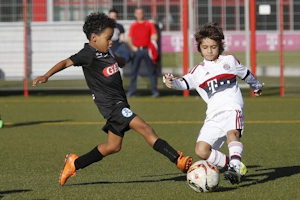Football for beginners, how to start a football career

The photo was taking from website fcstolica_ru
Football has long held the first place as one of the most popular games not only at the team level, but also in global sports. In many countries it is played all the time, and in some families it is considered a kind of tradition.
The photo was taking from website LRT
Therefore, it is not surprising that when choosing a sports section for children's development, parents often favour football for several reasons:
1. A great way of socialisation. The child learns to interact with others, being part of a group, to follow the rules, to be responsible not only for himself, but also for the team.
2. All-round physical development. During running, joints, martial arts and practically all game activities almost all major muscle groups are used, stamina and general physical development is increased.
3. Mental development. A cognitive approach to training increases the ability to focus on the task at hand, which is especially important in the digital age when kids are surrounded by distractions everywhere. Not to mention that tactics and strategy play a key role in football, and young players unconsciously learn to anticipate their opponent's moves and plan their own.
The photo was taking from website Mobilesport_ch
In this article, we'll talk about the ‘Little Friends’ and ‘First Steps’ categories. When organising the training process for these categories it is necessary to take into account the main features of children from 5 to 9 years old:
- Short attention span. Football, like any game, should be primarily interesting to the child. If you overload attention with rules and tactics, the young player can quickly lose interest in the game, which is not useful for either the student or the team.
- Self-orientation (egocentrism). Football is a game of personalities, and training should provide maximum opportunities for self-expression. Children really enjoy playing, touching the ball. Organise the sessions so that with a minimum of explanation, maximum opportunities to interact with the ball are given. Dividing the team into small practice groups will increase contact time with it.
- Constant movement and inefficient distribution of effort. Active exercises should be short, varied, with many small intervals for rest. Short workouts are much more beneficial than long and boring ones. In addition, they can quickly tire a young player.
The photo was taking from website International football events
- Psychological vulnerability. Emphasise the positives and praise children. Support is an important aspect of teaching and learning and has a significant impact on engagement.
- Lack of interest in team play. The golden rule of learning is to move from simple to complex. First you need to involve the child in the game itself and gradually introduce tactical elements into the game format so that students learn to practise the approach subconsciously. Gradually create situations where they need to make decisions on their own. This will help develop concentration and football thinking.
- Poor co-ordination between eye and foot or eye and hand movements. It is important to focus on improving basic motor skills during the initial developmental stage.
The photo was taking from website Football_ch
As in any other sport, in football there are laws and principles of training athletes and the training process should be based on them. One of the principles of technique training is that the mastery of a technical element is based on good coordination within and between muscles, which is achieved through repeated repetition of the same movement first in static conditions and then in game conditions.
The photo was taking from website ice_profy_ru
When planning lessons for children, it is important to find an optimal balance between the load interesting for them (the game process itself) and less interesting, but useful for learning football (general and special training). One of the coach's tasks is to make the less interesting but more useful exercises more exciting and thrilling in the form of competitions or various relay races.
The photo was taking from website Football_ch
Use all your imagination to create a series of fun and exciting football-related activities to keep little footballers interested in the game. Try to participate in the training session as well. Show them how to complete a task. A visual example is much more effective than a verbal one at any age, and especially for toddlers.
The photo was taking from website ice_profy_ru
It is important not to forget that not everyone will become a professional, and that in the process of training the role of the coach is not only to be a football mentor, but also an educator, which is often much more important and responsible.
Become not only a coach, but also a friend and authority for the child. Try to create the most comfortable atmosphere possible, where the young footballer will want to return and where he can enjoy his development.
Good luck to you and your players!
Find Football tournament













